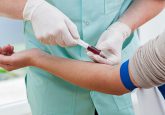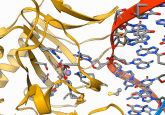Proteomics analysis could help diagnose inflammatory skin diseases

Researchers from Leeds University Hospital (UK) have developed a noninvasive epidermal sampling test to differentiate between eczema and psoriasis when diagnosing inflammatory skin diseases. This has the potential to be implemented as a point of care test to allow accurate diagnosis and stratification into appropriate therapeutic pathways by physicians.
Eczema and psoriasis are the most common inflammatory skin diseases, sharing both morphologic and histologic features. Their inflammatory responses may cause diagnostic problems if lesions are chronic, in specific anatomical locations such as the hand, flexural areas and scalp, or present atypically.
In the study, lesional psoriasis, eczema and healthy skin was sampled by noninvasive tape‐stripping, followed by protein extraction and quantification. Protein expression was analyzed by LC–MS/MS using an Orbitrap system, and the results analyzed using MaxQuant quantitative proteomics and Perseus software. ELISA-based approaches were then used to verify epidermal mediators.
Elevated levels of IL-36-gamma were reported for diagnosing psoriasis at a specificity and sensitivity of 100% and 94.44% respectively. Psoriasis patients also presented elevated levels of IL-8, IL-18, CXCL1, S100A8/9 and HBP2, whilst patients with atopic dermatitis displayed elevated levels of CCL17 (TARC) and CCL27 (CTACK).
“By determining levels of IL-36-gamma, a diagnosis can be made without subjecting patients to invasive biopsies,” explained Anna Berekmeri, Leeds University Hospital. “Of course we can always do a skin biopsy, but the patient has to undergo the procedure, the biopsy is costly and we have to wait weeks for the results.”
For skin-stripping, an adhesive disk is applied to the skin surface for 30 seconds and corneocytes that are collected from the most superficial layers of the skin are analyzed. The study reported a total of 220 proteins identified by mass spectrometry, 78 of which showed significantly different expression in psoriasis and 45 in eczema, compared to healthy samples. When comparing the two disease states, 18 epidermal proteins had significantly different expression in psoriasis compared to eczema.
From the study, the biomarkers appear robust enough on their own to suggest they could be used clinically, however, comparison with biopsy is required to be confident in the results. The researchers concluded: “The combined detection of disease biomarkers from quantitative proteomic analysis of non‐invasive epidermal sampling has great potential for disease endotyping, treatment profiling and noninvasive follow up of therapeutic responses.”
Sources: Berekmeri A, Alase A, Macleod T et al. Proteomics analysis shows that non-invasive epidermal sampling is a robust diagnostic approach for inflammatory skin diseases. Wiley, ISDS, Abstract 90 (2018); www.medpagetoday.com/meetingcoverage/isds/76958






